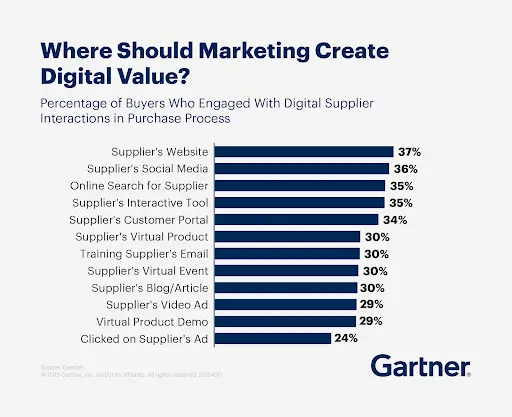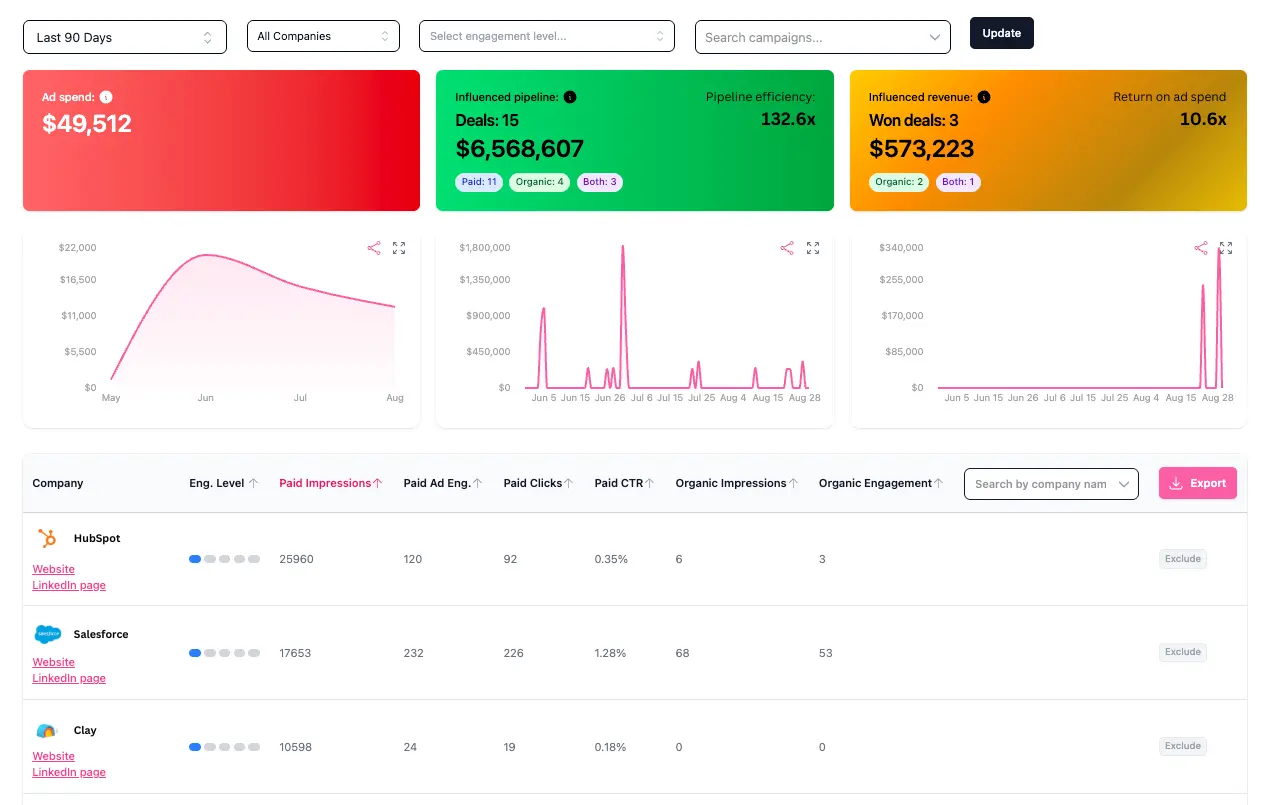LinkedIn Ads Attribution: How to Actually Connect Impressions to Pipeline and Revenue
Quick Links
LinkedIn's native analytics show that people like and engage with your advertising campaigns, so they must be successful, right?
But when your boss asks for a breakdown on how much revenue the campaigns have generated, or the impact of your ads on pipeline, you have only one answer: "I'm not sure."
LinkedIn ads attribution is a major hurdle for any marketer using the platform to reach B2B buyers. Its native reporting features only show so much data. Other than top-level insights like clicks and direct conversions that happen immediately after ad interaction, you're left in the dark.
That doesn't always have to be the case. You just need a smarter, influence-based approach to LinkedIn attribution.
Here's how to go beyond surface-level reporting and build a true LinkedIn revenue attribution report using impressions and CRM data.
The attribution trap in B2B marketing
Attribution has long been a challenge for B2B marketers. Ask one to tell you how much revenue an individual campaign contributed to sales and you'll see a puzzled look on their face with a shrugged, "I'm not entirely sure."
The issue with LinkedIn Ads native reporting, in particular, is that it stops at clicks and conversions. This contradicts the B2B buying process—proven to be anything but linear.
Buyers don't click on ads. They see them for a long time and then they will book a demo when they are ready. They will most likely get a conversion at direct traffic or organic source (such as branded search), but LinkedIn Ads likely have played a huge part in the journey.
Research supports this: the average B2B customer journey spans 192 days and involves just over 62 touchpoints. Gartner says these include:
- A supplier's website
- Social media profiles
- Online search
- Interactive tools
- Customer portals
Traditional revenue attribution (especially last-click) misses most of what actually happens in the sales process. This creates a false narrative that LinkedIn advertising "doesn't work"—when in fact, it just isn't measured correctly.

Why standard LinkedIn analytics fall short
LinkedIn Analytics has its own native reporting dashboard to show advertisers the impact of their campaigns. This is accessible through Campaign Manager and displays key metrics—such as impressions, click-through rate, and conversions—for each ad.
While this feature is great for basic reporting, it does have significant limitations:
- No influence metrics: Native LinkedIn analytics show you clicks, impressions, CTRs, direct conversions—but it doesn't tell you how LinkedIn Ads have influenced customers throughout their buying journey. It might lead to false conclusions ("This campaign was a failure!") because the default reporting and attribution model doesn't reflect the customer journey from end-to-end.
- Lack of visibility: Because you don't know what campaigns companies in your target audience are seeing over time, it's significantly harder to attribute revenue to your LinkedIn campaigns.
- Siloed pipeline data: There's no way to connect impressions to pipeline or revenue natively (at least not at the company-level) with LinkedIn's native analytics feature. There's also no way to send LinkedIn Ads data to HubSpot or Salesforce and use that data for reporting and outbound sales workflows.
A better approach: Influence-based attribution
We know the limitations of LinkedIn's revenue attribution model. This poses the question: If that approach doesn't work, what does?
The influence-based revenue attribution model is about connecting visibility to action. Instead of optimizing for last-click (and thinking a campaign is a failure when audiences don't take immediate action, even when we know that contradicts B2B buying behavior), it focuses on influence throughout the entire buyer journey.
A buyer might see your ad 100 times before they ever engage. They might view one ad on their lunch break, another when they're just aware of a problem, and another when they're shortlisting vendors to solve it.
This is not unusual: just 5% of B2B buyers are in the market to buy at any given time.
Influence-based attribution is how you measure what's actually working in the long term—even when no one clicks or converts immediately after viewing your ad.
What we do at Fibbler (and why it matters)
We know first-hand the challenge of marketing attribution. That's why we built Fibbler.
Fibbler connects LinkedIn Ads data with HubSpot or Salesforce. We match which companies saw your ads with which deals entered your pipeline. This gives you an "influenced revenue" view— not just who clicked, but who booked a demo after seeing your ads.
You can also segment data to uncover which campaigns leads have seen in the lead up to a conversion to see what's actually influencing pipeline. With this insight, you can optimize based on real revenue, not just vanity metrics.
"In the era of no-clicks, Fibbler makes it possible to measure the influence of LinkedIn Ads for companies of any scale." —Canberk Beker, founder of ROASted and digital marketing partner at LinkedIn

Let's put that into practice and say a mid-sized B2B SaaS company runs LinkedIn ads that target a high value account list you've pulled from a sales intelligence tool like Cognism. You run a range of ad formats—including thought leadership ad (TLAs) and single image ads—to reach this cold audience and build credibility.
LinkedIn Ads' native revenue reporting might show zero conversions over the few weeks your campaigns are active.
In reality, Fibbler shows that:
- People in a "Head of Marketing" role who've viewed your ads are more likely to request a proposal.
- Target accounts viewed your TLA campaign six times, on average, before registering for a demo.
Not only did your campaigns have more of a (measurable) impact than you thought, but better LinkedIn revenue attribution ultimately leads to better strategy.
Using the same insight: perhaps you assign more budget to your product demonstration campaign, or adjust your audience targeting to focus on reaching more people in a "Head of Marketing" role.
These small tweaks can significantly improve campaign performance by reaching the right audience and maximizing ad spend.
The best marketers don't just track clicks—they track impact
LinkedIn isn't just a performance channel—it's a brand channel that shapes decisions. Yet you can't run a great demand gen oraccount-based marketing campaign without understanding influence.
Take stock of the current B2B buying process. Click a link > book a demo > become a customer isn't what most of them look like. It's a much longer affair, spanning several months and involving multiple stakeholders.
If your LinkedIn analytics reporting tool isn't built for B2B buying behavior, it's lying to you.
Want to see what your LinkedIn ads are really doing?
Connect LinkedIn Ads to your CRM and generate your first "influenced revenue" report with Fibbler. Get started today.
"We got Fibbler up and running in less than a day and it's already syncing our LinkedIn Impressions data straight into HubSpot. It has really helped our marketing and sales teams get a clearer picture of how our demand generation efforts are impacting the pipeline. Absolutely love both the product and the price!" —Alen Todorov, head of marketing at SEOmonitor.com
Written by

Adam Holmgren
CEO @ Fibbler
